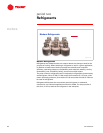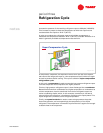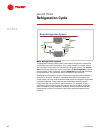
TRG-TRC003-EN 15
period two
Refrigerants
notes
have different capacities for absorbing heat. This capacity is a property of the
substance called specific heat.
Suppose equal quantities of two different liquids, $ and %, both at room
temperature, are heated. The gas burners are lighted and adjusted so that each
is burning exactly the same quantity of gas over the same time period, ensuring
that each container of liquid receives the same quantity of heat. After a period
of time, the thermometer in the container of liquid $ indicates 140°F [60°C],
while the thermometer in the container of liquid % indicates 200°F [93.3°C].
Even though equal quantities of the two liquids were supplied with exactly the
same
quantity
of heat, why does liquid % reach a higher temperature than
liquid $?
The reason is that liquid % has less capacity for absorbing heat than liquid $.
This capacity for absorbing heat is called specific heat. The specific heat of a
substance is defined as the quantity of heat, in Btus, required to raise the
temperature of 1 lb of that substance 1°F.
Similarly, in metric units, specific heat is defined as the quantity of heat, in kJs,
required to raise the temperature of 1 kg of that substance 1°C.
$
$
%
%
6SHFLILF+HDW
)
)
>&@
>&@
)
)
>&@
>&@
Figure 25


















